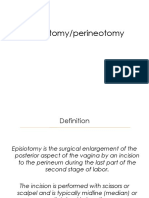0 ratings0% found this document useful (0 votes)
290 viewsMCN - Milestones For Fetal Growth and Development
MCN - Milestones For Fetal Growth and Development
Uploaded by
Benjo Dela CruzBy the end of the 4th week of gestation, the embryo is a group of rapidly growing cells that has begun to form basic structures like the spinal cord, heart, and limb buds. By the 8th week, organogenesis is complete and facial features are discernible. At 12 weeks, movements are possible, bone ossification has begun, and sex is distinguishable. Fetal development continues with additional growth and maturation of organs, tissues, and reflexes throughout the second and third trimesters in preparation for life outside the womb.
Copyright:
Attribution Non-Commercial (BY-NC)
Available Formats
Download as DOCX, PDF, TXT or read online from Scribd
MCN - Milestones For Fetal Growth and Development
MCN - Milestones For Fetal Growth and Development
Uploaded by
Benjo Dela Cruz0 ratings0% found this document useful (0 votes)
290 views5 pagesBy the end of the 4th week of gestation, the embryo is a group of rapidly growing cells that has begun to form basic structures like the spinal cord, heart, and limb buds. By the 8th week, organogenesis is complete and facial features are discernible. At 12 weeks, movements are possible, bone ossification has begun, and sex is distinguishable. Fetal development continues with additional growth and maturation of organs, tissues, and reflexes throughout the second and third trimesters in preparation for life outside the womb.
Original Description:
Milestones for Fetal Growth and Development
Original Title
MCN - Milestones for Fetal Growth and Development
Copyright
© Attribution Non-Commercial (BY-NC)
Available Formats
DOCX, PDF, TXT or read online from Scribd
Share this document
Did you find this document useful?
Is this content inappropriate?
By the end of the 4th week of gestation, the embryo is a group of rapidly growing cells that has begun to form basic structures like the spinal cord, heart, and limb buds. By the 8th week, organogenesis is complete and facial features are discernible. At 12 weeks, movements are possible, bone ossification has begun, and sex is distinguishable. Fetal development continues with additional growth and maturation of organs, tissues, and reflexes throughout the second and third trimesters in preparation for life outside the womb.
Copyright:
Attribution Non-Commercial (BY-NC)
Available Formats
Download as DOCX, PDF, TXT or read online from Scribd
Download as docx, pdf, or txt
0 ratings0% found this document useful (0 votes)
290 views5 pagesMCN - Milestones For Fetal Growth and Development
MCN - Milestones For Fetal Growth and Development
Uploaded by
Benjo Dela CruzBy the end of the 4th week of gestation, the embryo is a group of rapidly growing cells that has begun to form basic structures like the spinal cord, heart, and limb buds. By the 8th week, organogenesis is complete and facial features are discernible. At 12 weeks, movements are possible, bone ossification has begun, and sex is distinguishable. Fetal development continues with additional growth and maturation of organs, tissues, and reflexes throughout the second and third trimesters in preparation for life outside the womb.
Copyright:
Attribution Non-Commercial (BY-NC)
Available Formats
Download as DOCX, PDF, TXT or read online from Scribd
Download as docx, pdf, or txt
You are on page 1of 5
MILESTONES FOR FETAL GROWTH AND DEVELOPMENT:
End of 4th Gestational Week
At the end of the fourth week of gestation, the human embryo is a group of rapidly growing cells but does not yet resemble a human being. Length: 0.751 cm Weight: 400 mg The spinal cord is formed and fused at the midpoint. Lateral wings that will form the body are folded forward to fuse at the midline. The head folds forward and becomes prominent, representing about one-third of the entire structure. The back is bent so that the head almost touches the tip of the tail. The rudimentary heart appears as a prominent bulge on the anterior surface. Arms and legs are budlike structures. Rudimentary eyes, ears, and nose are discernible
End of 8th Gestational Week
Length: 2.5 cm (1 in) Weight: 20 g Organogenesis is complete. The heart, with a septum and valves, is beating rhythmically. Facial features are definitely discernible. Arms and legs have developed. External genitalia are forming, but sex is not yet distinguishable by simple observation. The primitive tail is regressing.
The abdomen bulges forward because the fetal intestine is growing so rapidly. An ultrasound shows a gestational sac, diagnostic of pregnancy.
End of 12th Gestational Week (First Trimester)
Length: 78 cm Weight: 45 g Nail beds are forming on fingers and toes. Spontaneous movements are possible, although they are usually too faint to be felt by the mother. Some reflexes, such as the Babinski reflex, are present. Bone ossification centers begin to form. Tooth buds are present. Sex is distinguishable by outward appearance. Urine secretion begins but may not yet be evident in amniotic fluid. The heartbeat is audible through Doppler technology.
End of 16th Gestational Week
Length: 1017 cm Weight: 55120 g Fetal heart sounds are audible by an ordinary stethoscope. Lanugo is well formed. Liver and pancreas are functioning. Fetus actively swallows amniotic fluid, demonstrating an intact but uncoordinated swallowing reflex; urine is present in amniotic fluid. Sex can be determined by ultrasound.
End of 20th Gestational Week
Length: 25 cm Weight: 223 g Spontaneous fetal movements can be sensed by the mother. Antibody production is possible. The hair forms on the head, extending to include eyebrows. Meconium is present in the upper intestine. Brown fat, a special fat that will aid in temperature regulation at birth, begins to be formed behind the kidneys, sternum, and posterior neck. Vernix caseosa begins to form and cover the skin. Passive antibody transfer from mother to fetus begins. Definite sleeping and activity patterns are distinguishable (the fetus has developed biorhythms that will guide sleep/wake patterns throughout life).
End of 24th Gestational Week (Second Trimester)
Length: 2836 cm Weight: 550 g Meconium is present as far as the rectum. Active production of lung surfactant begins. Eyebrows and eyelashes become well defined. Eyelids, previously fused since the 12th week, now open. Pupils are capable of reacting to light. When fetuses reach 24 weeks, or 601 g, they have achieved a practical low-end age of viability (earliest age at which fetuses could survive if born at that time), if they are cared for after birth in a modern intensive care facility. Hearing can be demonstrated by response to sudden sound
End of 28th Gestational Week
Length: 3538 cm Weight: 1200 g Lung alveoli begin to mature, and surfactant can be demonstrated in amniotic fluid. Testes begin to descend into the scrotal sac from the lower abdominal cavity. The blood vessels of the retina are formed but thin and extremely susceptible to damage from high oxygen concentrations (an important consideration when caring for preterm infants who need oxygen).
End of 32nd Gestational Week
Length: 3843 cm Weight: 1600 g Subcutaneous fat begins to be deposited (the former stringy, little old man appearance is lost). Fetus responds by movement to sounds outside the mothers body. Active Moro reflex is present. Iron stores, which provide iron for the time during which the neonate will ingest only milk after birth, are beginning to be developed. Fingernails grow to reach the end of fingertips.
End of 36th Gestational Week
Length: 4248 cm Weight: 18002700 g (56 lb) Body stores of glycogen, iron, carbohydrate, and calcium are deposited. Additional amounts of subcutaneous fat are deposited. Sole of the foot has only one or two crisscross creases, compared with the full crisscross pattern that will be evident at term. Amount of lanugo begins to diminish. Most babies turn into a vertex (head down) presentation during this month.
End of 40th Gestational Week (Third Trimester)
Length: 4852 cm (crown to rump, 3537 cm) Weight: 3000 g (77.5 lb) Fetus kicks actively, hard enough to cause the mother considerable discomfort. Fetal hemoglobin begins its conversion to adult hemoglobin. The conversion is so rapid that, at birth, about 20% of hemoglobin will be adult in character. Vernix caseosa is fully formed. Fingernails extend over the fingertips. Creases on the soles of the feet cover at least two thirds of the surface.
You might also like
- SR Buyer Guide DIGITAL PDFDocument449 pagesSR Buyer Guide DIGITAL PDFMichael Carney67% (3)
- MH GAPDocument5 pagesMH GAPAira Kharys P. VerdidaNo ratings yet
- Volume Seven Nutrition BookDocument21 pagesVolume Seven Nutrition BookMiha Bek100% (1)
- Drugs Study and Discharge Plan Arnold and SelwynDocument17 pagesDrugs Study and Discharge Plan Arnold and SelwynArnold ZamoroNo ratings yet
- Guide To Vitamin b1Document0 pagesGuide To Vitamin b1teddypol100% (1)
- Ans Unit 6 PDFDocument2 pagesAns Unit 6 PDFChiara MiniNo ratings yet
- Blood Test Interpretation PDFDocument10 pagesBlood Test Interpretation PDFstore.hrNo ratings yet
- Severe Pre EclampsiaDocument110 pagesSevere Pre EclampsiaJachel Kathleen LaguioNo ratings yet
- Micro para The IntroductionDocument51 pagesMicro para The IntroductionknotstmNo ratings yet
- Physical Assessment DaraDocument3 pagesPhysical Assessment DaraMichael Bon MargajaNo ratings yet
- CHN CH 3 Newborn Screening and Other Child ProgramsDocument4 pagesCHN CH 3 Newborn Screening and Other Child ProgramsElaiza RiegoNo ratings yet
- Social Problems in The Philippines I-Witness: "Black Manila", A Documentary by Howie SeverinoDocument1 pageSocial Problems in The Philippines I-Witness: "Black Manila", A Documentary by Howie SeverinoMhelai Dela CruzNo ratings yet
- 3LP 2020ncm105Document7 pages3LP 2020ncm105Margarette GeresNo ratings yet
- Case Study - Repeat LtcsDocument9 pagesCase Study - Repeat LtcsAnna SantosNo ratings yet
- Print OutDocument8 pagesPrint OutMadhu BalaNo ratings yet
- Chapter 1. Physical Activity and Exercise: Learning OutcomesDocument5 pagesChapter 1. Physical Activity and Exercise: Learning OutcomesKrish NalingNo ratings yet
- Septic Abortion PhysioDocument66 pagesSeptic Abortion PhysioChristiemae_An_6363No ratings yet
- Physiologic and Psychologic Changes in PregnancyDocument41 pagesPhysiologic and Psychologic Changes in PregnancyAlessandra Franchesca CortezNo ratings yet
- MATERNAL NURSING Commonly Used AbbreviationsDocument4 pagesMATERNAL NURSING Commonly Used Abbreviations3amabelle arevaloNo ratings yet
- Beronio, Gracel Caye M. - Module 2 - AntepartumDocument12 pagesBeronio, Gracel Caye M. - Module 2 - AntepartumGracel Caye Maon BeronioNo ratings yet
- EpisiotomyDocument16 pagesEpisiotomyRosu GeorgeNo ratings yet
- Integrated Management of Childhood IllnessDocument18 pagesIntegrated Management of Childhood IllnessRika Mae100% (1)
- Allen Part Pedia CaseDocument3 pagesAllen Part Pedia CasePaul Michael Baguhin0% (1)
- Case Study SlideshowDocument48 pagesCase Study Slideshowapi-3342471330% (1)
- Drugs Affecting The Male Reproductive SystemDocument24 pagesDrugs Affecting The Male Reproductive SystemAkia Cayasan BayaNo ratings yet
- A Framework For Maternal and Child Health Nursing Care NCM 107Document3 pagesA Framework For Maternal and Child Health Nursing Care NCM 107Kyle VargasNo ratings yet
- Pedia OkeDocument6 pagesPedia OkeBianca DizonNo ratings yet
- Pregnancy Uterus Fetus Embryo: Morbidity Selectively Reduce Multiple PregnancyDocument4 pagesPregnancy Uterus Fetus Embryo: Morbidity Selectively Reduce Multiple Pregnancynyzgirl17No ratings yet
- Growth & DevelopmentDocument2 pagesGrowth & DevelopmentSofia Marie GalendezNo ratings yet
- TFN Research Assignment II.Document6 pagesTFN Research Assignment II.Marco Calvara100% (1)
- Newborn Screening TestsDocument4 pagesNewborn Screening TestsshanereaNo ratings yet
- Chapter 9: Nursing Care of The Growing FetusDocument20 pagesChapter 9: Nursing Care of The Growing FetusiMaibelle BelleNo ratings yet
- Nursing Research-AbstractDocument3 pagesNursing Research-AbstractKatherine 'Chingboo' Leonico LaudNo ratings yet
- Hypertensive Disorders of Pregnancy Teaching PlanDocument5 pagesHypertensive Disorders of Pregnancy Teaching PlanMary Grace Belmonte100% (1)
- Critical Reading, Writing and Thinking: Lady Ciane L. CruzDocument5 pagesCritical Reading, Writing and Thinking: Lady Ciane L. CruzROBERT JOHN PATAG0% (2)
- Gestational HypertensionDocument6 pagesGestational HypertensionDimitrisSoulisNo ratings yet
- Anatomy and Physiology For Small Gestational Age InfantDocument4 pagesAnatomy and Physiology For Small Gestational Age InfantTel SisonNo ratings yet
- Therapeutic Vs Non Therapeutic CommunicationDocument2 pagesTherapeutic Vs Non Therapeutic CommunicationImee TolentinoNo ratings yet
- Iligan City Hospital 1Document3 pagesIligan City Hospital 1danny17phNo ratings yet
- Premature Rupture of MembraneDocument5 pagesPremature Rupture of MembraneEspiritu, Chriscel100% (1)
- Case Study: Metro Manila Developmental Screening TestDocument33 pagesCase Study: Metro Manila Developmental Screening Testjhezelle05100% (1)
- CAJA, RENZO GABRIEL, BSN 2-1 NCM109-Midterm ModuleDocument14 pagesCAJA, RENZO GABRIEL, BSN 2-1 NCM109-Midterm ModuleRenzo GabrielNo ratings yet
- Guidelines For The Integrated Management of Severe Acute Malnutrition in and Out Patient Treatment 12.2011Document182 pagesGuidelines For The Integrated Management of Severe Acute Malnutrition in and Out Patient Treatment 12.2011Jonathan Renier VerzosaNo ratings yet
- Myoma Final Power PointDocument45 pagesMyoma Final Power Pointicesexy100% (1)
- Sample FCP GDocument21 pagesSample FCP GKeren GaciasNo ratings yet
- CASE DISCUSSION Subgroup 1 1Document112 pagesCASE DISCUSSION Subgroup 1 1Kartik SharmaNo ratings yet
- Theories of Aging 2022Document12 pagesTheories of Aging 2022Lara Victoria DuenasNo ratings yet
- Normal Spontaneous DeliveryDocument1 pageNormal Spontaneous DeliveryGi GiNo ratings yet
- Module 2 National Immunization Program (Npi) - MihpDocument15 pagesModule 2 National Immunization Program (Npi) - MihpNurhaifa Mocadema100% (1)
- Multiple GestationDocument24 pagesMultiple GestationNura BamaiyiNo ratings yet
- Cerebral PalsyDocument20 pagesCerebral PalsyاسيرالاحزانNo ratings yet
- Frameworks of MCHNDocument55 pagesFrameworks of MCHNSarah Jane MaganteNo ratings yet
- Rural Health Unit - Rle: November 4, 2019 RHU, Enrile CagayanDocument5 pagesRural Health Unit - Rle: November 4, 2019 RHU, Enrile CagayanJay-Lord Soriano AchanzarNo ratings yet
- Uterine ProlapseDocument21 pagesUterine ProlapseFau Fau DheoboNo ratings yet
- Abortion and Ectopic PregnancyDocument3 pagesAbortion and Ectopic PregnancyJefelson Eu Palaña NahidNo ratings yet
- Journal Study Regarding PCAP WashingtonDocument1 pageJournal Study Regarding PCAP WashingtonLuis WashingtonNo ratings yet
- The Shape, Size, Mobility, and Consistence of What He or She FeelsDocument3 pagesThe Shape, Size, Mobility, and Consistence of What He or She FeelsPrincess Pilove Gawongna100% (1)
- CASE PRESENTATION 2nd Sem FINALS Family Care StudyDocument44 pagesCASE PRESENTATION 2nd Sem FINALS Family Care StudyJohn MajanNo ratings yet
- Cesarean Section Report Richard LimDocument48 pagesCesarean Section Report Richard LimEj PogiNo ratings yet
- Pyloric StenosisDocument5 pagesPyloric Stenosisensoooooooooo100% (1)
- Shoulder Dystocia Group 3 Revised FinalDocument41 pagesShoulder Dystocia Group 3 Revised FinalSam Eugenio100% (1)
- Nursing Care of A Family With A High-Risk Newborn Nursing Care of A Family With A High-Risk NewbornDocument27 pagesNursing Care of A Family With A High-Risk Newborn Nursing Care of A Family With A High-Risk NewbornJoanna Mie Estrosos100% (1)
- Severe Acute MalnutritionDocument4 pagesSevere Acute MalnutritionAlemayehu DargeNo ratings yet
- The politics of hunger: Protest, poverty and policy in England, <i>c.</i> 1750–<i>c.</i> 1840From EverandThe politics of hunger: Protest, poverty and policy in England, <i>c.</i> 1750–<i>c.</i> 1840No ratings yet
- Ventricular Septal Defect, A Simple Guide To The Condition, Treatment And Related ConditionsFrom EverandVentricular Septal Defect, A Simple Guide To The Condition, Treatment And Related ConditionsNo ratings yet
- January 25, 2010 IDocument75 pagesJanuary 25, 2010 IomairfarooqNo ratings yet
- Journal of Clinical Gerontology & Geriatrics: Camilla Jing Hwa Chern, BS, Shyh-Dye Lee, MD, MPHDocument5 pagesJournal of Clinical Gerontology & Geriatrics: Camilla Jing Hwa Chern, BS, Shyh-Dye Lee, MD, MPHEdith Frederick LiemNo ratings yet
- Mental HealthDocument20 pagesMental HealthShaleni SharvikaNo ratings yet
- MS Exam 2Document34 pagesMS Exam 2David LopezNo ratings yet
- Thus Speaketh The Stomach Ehret 1923.Jpg TextDocument16 pagesThus Speaketh The Stomach Ehret 1923.Jpg TextSabari Selvi67% (3)
- Superwoman Syndrome BiblioDocument42 pagesSuperwoman Syndrome BiblioJunaid AhmedNo ratings yet
- UNDP Lesson PlanDocument9 pagesUNDP Lesson Plandasij3880No ratings yet
- Technical ReportDocument24 pagesTechnical ReportAngeline Joyce RamirezNo ratings yet
- Blaylock Wellness Report: Probiotics: Bacteria That Help Your BrainDocument13 pagesBlaylock Wellness Report: Probiotics: Bacteria That Help Your BrainRAMO STEF SZEKERESNo ratings yet
- Breastfeeding God's Way - Nancy CampbellDocument6 pagesBreastfeeding God's Way - Nancy CampbellElizabeth DamingNo ratings yet
- King Anthony Diet PlanDocument4 pagesKing Anthony Diet PlanGabriella Coronell0% (1)
- Ghid CardiovascularDocument78 pagesGhid Cardiovasculardiudiu93No ratings yet
- Eating Disorders FactsheetDocument16 pagesEating Disorders FactsheetGabriela VladNo ratings yet
- Beggs Mechanotherapy Ortho / Orthodontic Courses by Indian Dental AcademyDocument130 pagesBeggs Mechanotherapy Ortho / Orthodontic Courses by Indian Dental Academyindian dental academy100% (6)
- Nutritional Farming: As Opposed To Organic FarmingDocument54 pagesNutritional Farming: As Opposed To Organic FarmingTrixy YuNo ratings yet
- Elizabeth Torres Resume Winter 2017Document3 pagesElizabeth Torres Resume Winter 2017api-341508379No ratings yet
- Urine Reagent Strips Package InsertDocument3 pagesUrine Reagent Strips Package InsertgeraldineNo ratings yet
- Workbook Unit 2Document8 pagesWorkbook Unit 2RoqueNo ratings yet
- LALLEMAND Sel Yeast in RuminantsDocument5 pagesLALLEMAND Sel Yeast in Ruminantsأمالي أريفينNo ratings yet
- SF8 With FormulaDocument1 pageSF8 With FormulaZenaida Cruz100% (2)
- 16 Noticeable Symptoms of Baby Girl During PregnanDocument12 pages16 Noticeable Symptoms of Baby Girl During Pregnansamgill66916No ratings yet
- 7thgrade - Five Components of Fitness and Fitt PrincipleDocument18 pages7thgrade - Five Components of Fitness and Fitt PrincipleMae Ann DaganosNo ratings yet
- Vegetable ProductionDocument7 pagesVegetable ProductionCarl Dave MagbanuaNo ratings yet
- FACT/ TIP: Foods Can Be Divided Into Different Groups, AccordingDocument28 pagesFACT/ TIP: Foods Can Be Divided Into Different Groups, Accordingjoycemafuleka11No ratings yet
- Up Your Bench Press 30lbs in 30 DaysDocument24 pagesUp Your Bench Press 30lbs in 30 DaysCharles Seek100% (1)

























































































